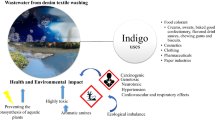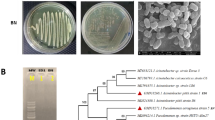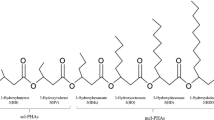Abstract
Textile wastewater (TW) from the Ban Phraek Weaving Group, Phatthalung, Thailand, showed high carbon (6405 mg/L) and nitrogen (54 mg/L) contents and a pH of 6.92, which, if not treated, will affect the environment. Newly isolated Enterobacter strain TS3 isolated from TW was used for TW treatment and PHA production under simultaneous batch conditions. The optimal conditions for the production of PHA by strain TS3 were as follows: 100% TW as the sole substrate, pH 6.92, 150 rpm, 35 °C, and 48 h of incubation at 83.94 ± 2.72% CDM (0.34 ± 0.02 g/L). The characterization of the extracted biopolymer proves the presence of short˗chain˗length˗co˗medium˗chain˗ length PHA (scl˗co˗mcl PHA) by Fourier transform infrared spectroscopy (FTIR) and gas chromatography-mass spectrometry (GC˗MS). This is the first report on Enterobacter TS3, which can produce scl˗co˗mcl PHA using TW as a substrate. Moreover, the treated wastewater after PHA cultivation met the criteria of the Water Quality Standard (Thailand).
Graphic Abstract








Similar content being viewed by others
References
dos Santos, A.B., Cervantes, F.J., van Lier, J.B.: Review paper on current technologies for decolorization of textile wastewaters: perspectives for anaerobic biotechnology. Bioresour. Technol. 98, 2369–2385 (2007)
Sarayu, K., Sandhya, S.: Current technologies for biological treatment of textile wastewater a review. Appl. Biochem. Biotechnol. 167, 645–661 (2012)
Lin, J.X., Zhang, Z., Li, L.: Biodegradation of reactive blue 13 in a two˗stage anaerobic/aerobic fluidized beds system with a Pseudomonas sp. isolate. Bioresour. Technol. 101, 34–40 (2010)
Wang, H., Zheng, X.W., Su, J.Q., Tian, Y.X., Xiong, J., Zheng, T.L.: Biological decolorization of the reactive dyes reactive black 5 by a novel isolated bacterial strain Enterobacter sp. EC3. J. Hazard. Mater. 171, 654–659 (2009)
Chen, B.Y., Lin, K.W., Wang, Y.M., Yen, C.Y.: Revealing interactive toxicity of aromatic amines to azo dye decolorizer Aeromonas hydrophila. J. Hazard. Mater. 166, 187–194 (2009)
Russ, R., Rau, J., Stolz, A.: The function of cytoplasmic flavin reductases in the reduction of azo dyes by bacteria. Appl Environ. Microbiol. 66(1429), 1434 (2020)
Dawkar, V.V., Jadhav, U.U., Ghodake, G.S., Govindwar, S.P.: Effect of inducers on the decolorization and biodegradation of textile azo dye navy blue 2GL by Bacillus sp. VUS. Biodegradation. 20, 777–787 (2009)
Rakkan, T., Chana, N., Chirapongsatonkul, N., U˗taynapun, K., Sangkharak, K.: Screening and identification of Basic Red 9˗degrading bacteria from textile wastewater and their ability to produce medium˗ and long chain length polyhydroxyalkanoate. J. Polym. Environ (2021). https://doi.org/10.1007/s10924-021-02206-2
Rakkan, T., Sangkharak, K.: Enhanced decolourisation and biodegradation of textile wastewater using single and mixed cultures of a newly isolated Enterobacter strain. Curr. Microbiol. 77, 4085–4094 (2020)
Reddy, C.S.K., Ghai, R., Rashmi, Kalia, V.C.: Polyhydroxyalkanoates: an overview. Bioresour. Technol. 87, 137–146 (2002)
Sangkharak, K., Prasertsan, P.: The production of polyhydroxyalkanoate by Bacillus licheniformis using sequential mutagenesis and optimization. Biotechnol. Bioprocess Eng. 18, 272–279 (2012)
APHA.: Standard methods for the examination of water and wastewater. American Public Health Association. Washington, DC (1999)
Sugahara, S., Suzuki, M., Kamiya, H., Yamamuro, M., Semura, H., Senga, Y., Egawa, M., Seike, Y.: Colorimetric determination of sulfide in microsamples. Anal Sci. 32, 1129–1131 (2016)
Anouzla, A., Abrouki, Y., Souabi, S., Safi, M., Rhbal, H.: Colour and COD removal of disperse dye solution by a novel coagulant: application of statistical design for the optimization and regression analysis. J. Hazard. Mater. 166, 1302–1306 (2009)
Lapara, T.M., Alleman, J.E., Pope, P.G.: Miniaturized closed reflux, colorimetric method for the determination of chemical oxygen demand. Waste Manage. 20, 295–298 (2000)
Shimizu, H., Shioya, S., Suga, K.I.: Cultivation condition for production of biodegradable poly˗β˗hydroxybutyric acid (PHB) production in Alcaligenes eutrophus H16 and Myoplans ruba R14 with respect to the dissolved oxygen tension in ammonium limited batch cultures. Eur. J. Appl. Microbiol. Biotechnol. 7, 1–10 (1990)
APHA.: Standard Methods for the examination of water and wastewater. American Public Health Association, Washington, DC (1992)
Steinbüchel, A., Wiese, S.: A Pseudomonas strain accumulating polyesters of 3˗hydroxybutyric acid and medium˗chain˗length 3˗hydroxyalkanoic acids. Appl. Microbiol. Biotechnol. 37, 691–697 (1992)
Kemavongse, K., Prasertsan, P., Upaichit, A., Methacanon, P.: Poly˗β˗hydroxyalkanoate production by halotolerant Rhodobacter sphaeroides U7. J. Microbiol. Biotechnol. 24, 2073–2085 (2008)
Shamala, T.R., Chandrashekar, A., Vijayendra, S.V., Kshama, L.: Identification of polyhydroxyalkanoate PHA producing Bacillus spp. using the polymerase chain reaction. J. Appl. Microbiol. 94, 369–374 (2003)
Abe, H., Doi, Y., Fukushima, T., Eya, H.: Biosynthesis from gluconate of a random copolyester consisting of 3˗hydroxybutyrate and medium˗chain˗length 3˗hydroxyalkanoates by Pseudomonas sp. 61˗3. Int. J. Biol. Macromol. 16(3), 115–119 (1994)
Steel, R.G.D., Torrie, J.H.: Principles and procedures of Statistics. McGraw˗Hill, New York (1980)
Horikoshi, K.: Alkaliphiles: some applications of their products for biotechnology. Microbiol. Mol. Biol. Rev. 63(4), 735–750 (1999)
Kim, Y.B., Lenz, R.W.: Polyesters from microorganisms. Adv. Biochem. Engin/Biotechnol. 71, 51–79 (2001)
Naheed, N., Jamil, N.: Optimization of biodegradable plastic production on sugar cane molasses in Enterobacter sp. SEL2. Braz. J. Microbiol. 45(2), 417–426 (2014)
Wang, F., Lee, S.Y.: Poly3˗hydroxybutyrate production with high productivity and high polymer content by a fed-batch culture of Alcaligenes latus under nitrogen limitation. Appl. Environ. Microbiol. 63, 3703–3706 (1997)
Gomaa, E.Z.: Production of polyhydroxyalkanoates (PHAs) by Bacillus subtilis and Escherichia coli grown on cane molasses fortified with ethanol. Braz Arch Boil Technol. 57, 145–154 (2014)
Bhagowati, P., Pradhan, S., Dash, H.R., Das, S.: Production, optimization and characterization of polyhydroxybutyrate, a biodegradable plastic by Bacillus spp. Biosci. Biotechnol. Biochem. 79, 1454–1463 (2015)
Palleroni, N.J., Palleroni, A.V.: Alcaligenes latus, a new species of hydrogen utilizing bacteria. Int. J. Syst. Bacteriol. 28, 416–424 (1978)
Wei, Y.H., Chen, W.C., Huang, C.K., Wu, H.S., Sun, Y.M., Lo, C.W., Janarthanan, O.M.: Screening and evaluation of polyhydroxybutyrate˗producing strains from indigenous isolate Cupriavidus taiwanensis strains. Int. J. Mol. Sci. 12(1), 252–265 (2011)
Mostafa, Y.S., Alrumman, S.A., Otaif, K.A., Alamri, S.A., Mostafa, M.S., Sahlabji, T.: Production and characterization of bioplastic by polyhydroxybutyrate accumulating Erythrobacter aquimaris isolated from mangrove rhizosphere. Molecules 25(1), 179–199 (2020)
Getachew, A., Woldesenbet, F.: Production of biodegradable plastic by polyhydroxybutyrate (PHB) accumulating bacteria using low cost agricultural waste material. BMC Res. Notes. 9, 509–518 (2016)
Swamy, J., Ramsay, J.A.: The evaluation of white rot fungi in the decoloration of textile dyes. Enzyme Microb. Technol. 24, 130–137 (1999)
Musa, H., Bolanle, B.B., Kasim, F., Arbain, D.: Screening and production of polyhydroxybutyrate (PHB) by bacterial strains isolated from rhizosphere soil of groundnut plants. Sains Malays. 45(10), 1469–1476 (2016)
Choonut, A., Prasertsan, P., Klomklao, S., Sangkharak, K.: Bacillus thermoamylovorans˗related strain isolated from high temperature sites as potential producers of medium˗chain˗length polyhydroxyalkanoate (mcl˗PHA). Curr. Microbiol. 77, 3044–3056 (2020)
Kshirsagar, P., Suttar, R., Nilegaonkar, S., Kulkarni, S., Kanekar, P.: Scale up production of polyhydroxyalkanoate (PHA) at different aeration, agitation and controlled dissolved oxygen levels in fermenter using Halomonas campisalis MCM B-1027. J. Biochem. Technol. 4(1), 512–517 (2014)
Zahari, M.A.K.M., Ariffin, H., Mokhtar, M.N., Salihon, J., Shirai, Y., Hassan, M.A.: Factors affecting poly(3˗hydroxybutyrate) production from oil palm frond juice by Cupriavidus necator (CCUG52238T). J Biomed Biotechnol (2012). https://doi.org/10.1155/2012/125865
Geethu, M., Vrundha, R., Raja, S., Chandrashekar, H.R., Divyashree, M.S.: Improvement of the production and characterisation of polyhydroxyalkanoate by Bacillus endophyticus using inexpensive carbon feedstock. J. Polym. Environ. 27, 917–928 (2019)
Mohandas, S.P., Balan, L., Lekshmi, N., Cubelio, S.S., Philip, R., Singh, I.S.B.: Production and characterization of polyhydroxybutyrate from Vibrio harveyi MCCB 284 utilizing glycerol as carbon source. J. Appl. Microbiol. 122(3), 698–707 (2016)
López˗Cuellar, M.R., Alba˗Flores, J., Rodríguez, J.N.G., Pérez˗Guevara, F.: Production of polyhydroxyalkanoates (PHAs) with canola oil as carbon source. Int. J. Biol. Macromol. 48, 74–80 (2011)
Gumel, A.M., Annuar, M.S.M., Heidelberg, T.: Biosynthesis and characterization of polyhydroxyalkanoates copolymers produced by Pseudomonas putida bet 001 isolated from palm oil mill effluent. PLoS One 7(9), 1–8 (2012)
Sathiyanarayanan, G., Bhatia, S.K., Song, H.S., Jeon, J.M., Kim, J., Lee, Y.K., Yang, Y.H.: Production and characterization of medium˗chain˗ength polyhydroxyalkanoate copolymer from Arctic psychrotrophic bacterium Pseudomonas sp. PAMC 28620. Int. J. Biol. Macromol. 97, 710–720 (2017)
Samrot, A.V., Avinesh, R.B., Sukeetha, S.D., Senthilkumar, P.: Accumulation of poly[(R)-3-hydroxyalkanoates] in Enterobacter cloacae SU˗1 during growth with two different carbon sources in batch culture. Appl. Biochem. Biotechnol. 163, 195–203 (2011)
Wecker, P., Moppert, X., Simon˗Colin, C., Berteaux˗Lecellier, V.C. : Discovery of a mcl˗PHA with unexpected biotechnical properties: the marine environment of French Polynesia as a source for PHA˗producing bacteria. AMB Express 5(74), 1–9 (2015)
Valentin, H.E., Dennis, D.: Production of poly(3˗hydroxybutyrate˗co˗4˗hydroxybutyrate) in recombinant Escherichia coli grown on glucose. J. Biotechnol. 58, 33–38 (1997)
Doi, Y., Kitamura, S., Abe, H.: Microbial synthesis and characterization of poly(3˗hydroxybutyrate˗co˗3˗hydroxyhexanoate). Macromolecules 28, 4822–4828 (1995)
Chen, G.Q., Wu, Q.: The application of polyhydroxyalkanoates as tissue engineering materials. Biomaterials 26, 6565–6578 (2005)
Rajan, K.P., Thomas, S.P., Gopanna, A., Chavali, M.: Polyhydroxybutyrate (PHB): a standout biopolymer for environmental sustainability. Springer, Cham (2018)
Poltronieri, P., Kumar, P.: Polyhydroxyalkanoates (PHAs) in industrial applications. Springer, Cham (2018)
Acknowledgements
The authors would like to acknowledge the support of Thailand Science Research and Innovation (TSRI) through the Royal Golden Jubilee Ph.D. (RGJ˗PHD) Program through Grant Number PHD/00073/2559 for RGJ˗PHD. Acknowledgment is also made to the Department of Chemistry, Faculty of Science, Thaksin University, Phatthalung Campus, Thailand. Finally, acknowledgement is made to Professor Dr. Ken’ichiro MATSUMOTO.
Author information
Authors and Affiliations
Corresponding author
Additional information
Publisher's Note
Springer Nature remains neutral with regard to jurisdictional claims in published maps and institutional affiliations.
Rights and permissions
About this article
Cite this article
Rakkan, T., Chana, N. & Sangkharak, K. The Integration of Textile Wastewater Treatment with Polyhydroxyalkanoate Production Using Newly Isolated Enterobacter Strain TS3. Waste Biomass Valor 13, 571–582 (2022). https://doi.org/10.1007/s12649-021-01504-z
Received:
Accepted:
Published:
Issue Date:
DOI: https://doi.org/10.1007/s12649-021-01504-z




